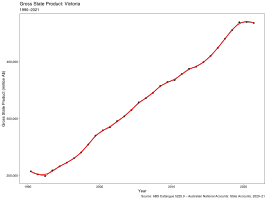States and territories by GSP per capita

> 100,000
100,000 - 80,000
80,000 - 70,000
70,000 - 60,000
< 60,000
| State or territory | GSP per capita (A$, 2021–22) |
GSP per capita growth (2021–22) |
GSP per capita as a ratio to national |
|---|---|---|---|
| 136,577 | 1.632 | ||
| 104,506 | 1.249 | ||
| 99,969 | 1.195 | ||
| 81,612 | 0.975 | ||
| 73,030 | 0.873 | ||
| 76,357 | 0.874 | ||
| 68,777 | 0.822 | ||
| 64,408 | 0.770 | ||
| 83,678 | 1.000 |









